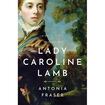
In Lady Caroline Lamb’s notorious first novel Glenarvon (1816), a young, married Anglo-Irish noblewoman becomes overwhelmed by emotional and existential crises, while the United Irish movement spreads in the years leading up to the 1798 Rebellion. Although set during the period of Lamb’s adolescence, Glenarvon dramatised her frustrations with married life in Regency high society, and her affair with the poet George Gordon, Lord Byron in England during spring 1812, when she was 27. The novel’s Irish setting was inspired by Lamb’s impressions of her family’s Kilkenny estate, where she spent the autumn of 1812, amid intensifying Irish demands for the removal of civil disabilities from Roman Catholics.
Antonia Fraser’s Lady Caroline Lamb recognises Glenarvon as the “astonishing achievement” of a woman whose literary talents were encouraged from childhood, though only as ornamental accomplishments. Frequently dismissed as over-emotional, Lamb claimed the right to be a woman of both intellect and feeling. The heroine of Glenarvon asserts herself as a ‘free spirit’ when advised to ‘control yourself, and disguise your feelings’ – and the phrase recurs in Lamb’s last novel, Ada Reis (1823), source of Fraser’s subtitle: ‘How vain are the commands of a despot, and of what avail is force against a free spirit’.
Fraser approaches Lady Caroline Lamb as an eminent historian of the British era of reform, and a major biographer of complex, victimised women including Mary, Queen of Scots and Marie Antoinette. She privileges the evidence of primary sources to recover Lamb the ambitious, politically informed writer from the sensationalist anecdotes recycled by Byron biographers, and historians of her husband’s political career (as Lord Melbourne, after her death). Such work has been long in progress in academic studies of Lamb, and is overdue to reach a wider public. If not deeply engaged with feminist, or other theoretical perspectives, Fraser’s concise biography successfully provides her intended ‘balanced estimate’ of Lamb’s personality and talents.
Caroline Lamb’s father, Frederick Ponsonby, succeeded as third Earl of Bessborough in the Irish peerage in 1793, inheriting estates including Bessborough House near Piltown, Co. Kilkenny (now Kildalton Agricultural College). Bessborough opposed the 1800 act of Union that returned legislation for Ireland to Westminster, and his family continued to support Irish Patriot Whig causes such as Catholic emancipation. Caroline’s mother Henrietta, née Spencer, further connected her to the Whig elite, being the sister of Georgiana, Duchess of Devonshire – while Henrietta’s many lovers included Richard Brinsley Sheridan.
As an earl’s daughter, Caroline retained the title ‘Lady’ after her marriage, aged 19, to the English Whig politician William Lamb in 1805. Her waiflike physique conformed to contemporary beauty standards – and she happily exploited her looks, despite her appreciation of Mary Wollstonecraft’s anti-fashion critique in A Vindication of the Rights of Woman (1792). Lamb also adopted male dress for practical purposes such as riding her horses astride, or entering Parliament to hear her husband speak – and took especial pleasure in wearing pageboy livery, famously during her relationship with Byron.
Fraser surveys the familiar episodes of the Byron affair without letting them dominate her narrative, from Lamb’s early assessment of Byron as ‘mad, bad, and dangerous to know’ (recorded by her friend, the Irish novelist Lady Morgan), to her performative act of self-harm in his presence at a ball in 1813. A similarly restrained, but compassionate account traces Lamb’s chaotic life after publishing Glenarvon, which saw her separate from William in 1825, and decline into the alcohol and laudanum dependencies that contributed to her death at 42 – all while resisting William’s relatives’ attempts to have her declared insane, and to confine her beloved son Augustus, who lived with epilepsy and learning disabilities. Fraser pays welcome attention to Lamb’s later creative endeavours – which included her novels Graham Hamilton (1821) and Ada Reis (1823); parodies of Byron’s poetry, and her patronage of composer Isaac Nathan, and fellow novelist William Godwin, Lamb’s confidant as she entered middle age, feeling like “the wreck of ... a gay little merry boat”.
While Jane Austen wrote, in Mansfield Park (1814), “Let other pens dwell on guilt and misery”, Lamb was content for one such pen to be hers. However, while frankly confronting the varieties of moral decay, Lamb shared with Austen, and Maria Edgeworth, a respect for the importance of education to the development of the independent mind. Lamb’s own ‘free spirit’ was nevertheless formed by her aristocratic temperament. Her sympathy for the Irish Patriot cause was tempered by a conservative Whig preference for rule by elites, shared by her husband, who was appointed Chief Secretary to the Lord Lieutenant of Ireland in 1827. But through her determined pursuits of intellectual and sensual experience, Lamb the entitled socialite gained what Fraser recognises as the ‘wry self-knowledge’ to articulate the paradoxes she inhabited as the early victim of a celebrity culture still blighted by sexual double standards.




